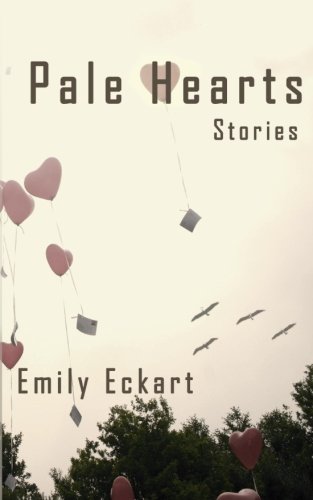 Reviewed by Ruth Latta
Reviewed by Ruth Latta
Pale Hearts
by Emily Eckart
Insomnia Publishing
Oct 2016, ISBN 13-978-098-639-755A, Paperback, 196pp
Emily Eckart’s debut short story collection, is unique and outstanding first and foremost for her literary craftswomanship. In “The Beech Tree”, the first story in the collection, she skilfully uses the imagery of trees, fruit and flowers in showing an unhappy girl’s relationship with her grandmother. More than just a detail of setting, the tree symbolizes the love between Grandma and her late husband, which flourished, grew large and endured. To the girl, the tree also represents Grandma herself. At one juncture, the girl turns from cutting her own body to carving her name repeatedly into the tree so as to be remembered. Eventually, she becomes the tree – rooted and growing.
The author uses her background in music in several stories, including the poignant “Counterpoint”, involving a couple in a career conflict. John, a church organist in a small Wisconsin town, loves Sylvia, a violinist who comes to terms with anxiety and wins an audition in Paris. As the novel opens, John begins an organ fugue. “The theme had come from Sylvia’s voice, the melody in the way she said, I’m moving.”
Pale Hearts should be read, too, for its unusual but insightful examination of contemporary social issues. “The Safety App” shows parents so fearful for their child’s safety that they adopt precautionary measures more suitable for an ex-convict.
“Peanut Butter” shows jealousy among teenage girls leading to an attempted murder.
In light of the recent current of misogyny in North America, “Do It With Someone You Love”, which is about the socialization of young men in our society, is especially timely. A group of freshmen pledged to a fraternity are going to a party at a frat house, where they will face an initiation rite. The brother in charge of them has shown them a picture of himself having sex with a girl, and has informed them that there must be “pics, or it didn’t happen.” The narrator and his buddies have been told by their mothers “that sex is only meaningful if we did it with someone we loved.” He and his friends have all met “that one older guy … who is totally in love with his wife”. But the wife usually isn’t “hot” and the “blissed-out” man is usually someone like a teacher, unsuccessful in worldly terms.
Over drinks, their fathers have explained that “in real life there are more talented people than there are spots for them” and that the way to get things in life is to join the right networks, like the fraternity. The story ends: “Even though we want to, there is no way that we can stop.”
Another story about teenagers, “The Way You Cover”, involves an affair of the heart and social media. Greg, soon to graduate from high school, has a crush on Kayla, a teenager who sings on YouTube. He decides to “do something memorable before graduation, something big… Meet her.” He uses the internet to find out where she lives, and since it is within driving distance, he goes there. Seeing her leave the house in her ancient vehicle, he follows her in his car to an upscale neighbourhood where a party is going on. They meet and strike up a rapport based on shared resentment of their inability to afford the universities which have accepted them. Then she learns that he has been following her, accuses him of stalking, and threatens him with the police if he doesn’t leave. To get back at her, Greg uses social media, and the outcome is surprising.
“An Inquiry into the Nature of Happiness” is also about stalking, although Eleanor, the narrator, calls it “people-watching with a purpose.” In a library carrel she finds a class ring inscribed with the name of Julia, a popular, fashionable, laughing student always surrounded by light-hearted, happy friends. How can she be oblivious to all the trouble in the world, Eleanor wonders. A history major, Eleanor deliberately studies grim events, reasoning that: “If she knew the worst that could happen, the absolute nadir of human experience, then nothing could ever harm her.”
Her friend and classmate Dave, her partner in sardonic awareness, has been out of touch for two weeks and she is worried. She emails to ask him what she should do about the ring. When he replies, from a psychiatric ward, he tells her to give it back, but instead, Eleanor delays, continuing to observe Julia. Further developments show Eleanor that she knows nothing about despair; the gold ring becomes a “millstone in her pocket”.
The fifteen thought-provoking stories in Pale Hearts are both literature and entertainment. Congratulations, Emily Eckart, for a stunning first book.
About the reviewer: Ruth Latta’s latest book is a young adult novel, Grace and the Secret Vault. For more information about this and her other books, visit http://ruthlattabooks.blogspot.com